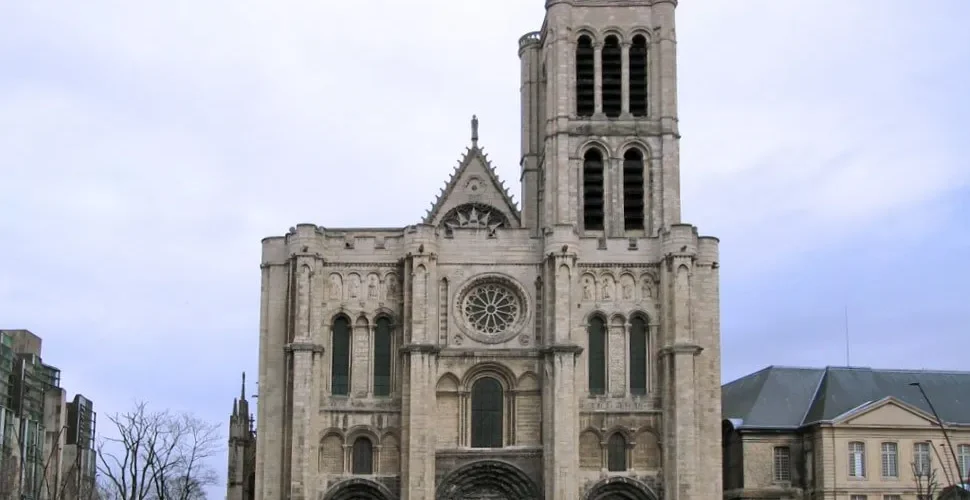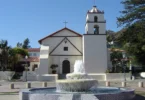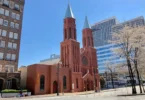Introduction
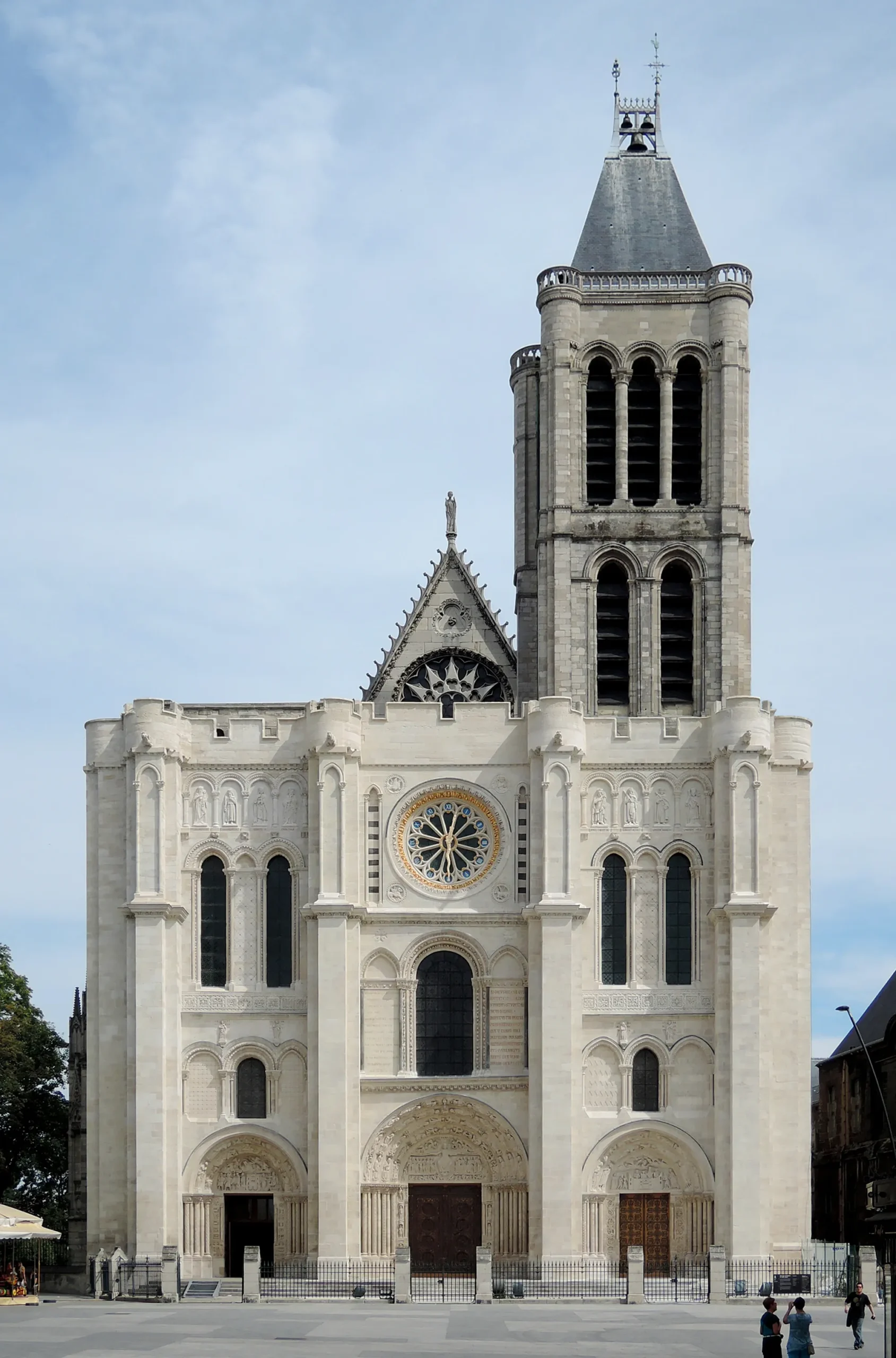
The Basilica of Saint-Denis is a basilica near Paris, France. It is famous for its architecture and as the burial place for many Kings of France. It is in the suburb of Saint Denis, which is in the north of Paris. Since 1966, it is the cathedral of the diocese of Saint-Denis. It is located in the Greater Paris area, about 5 kilometres (3.1 mi) from Paris. The Basilica is named after Saint Denis. Saint Denis is the patron saint of France. He was also the first Bishop of Paris.
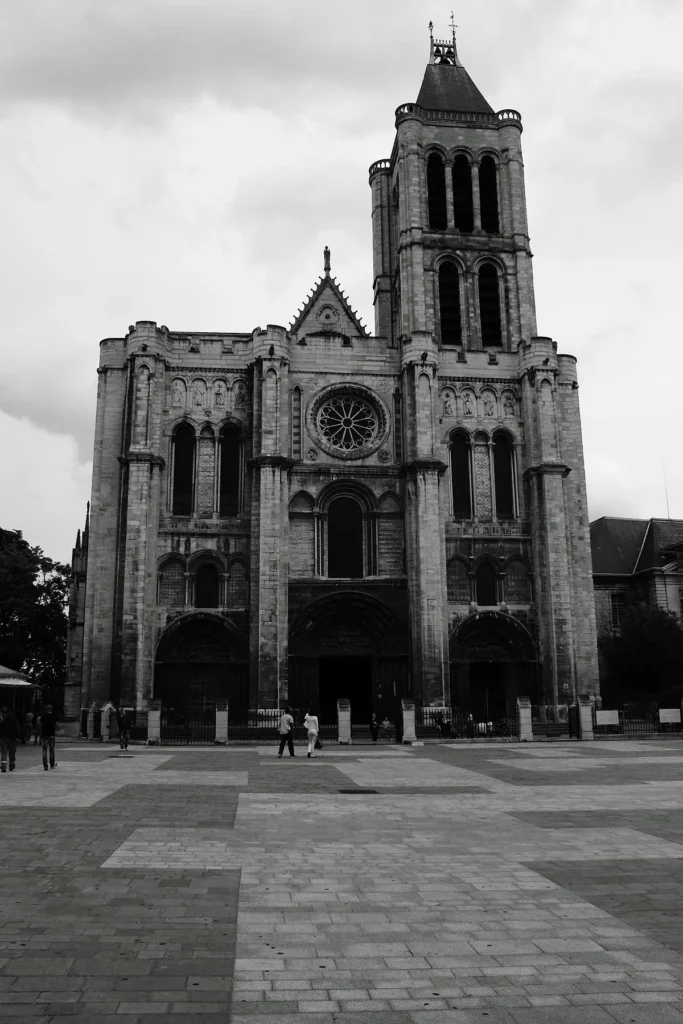
The Basilica of Saint-Denis (French: Basilique royale de Saint-Denis, now formally known as the Basilique-cathédrale de Saint-Denis) is a large former medieval abbey church and present cathedral in the commune of Saint-Denis, a northern suburb of Paris. The building is of singular importance historically and architecturally as its choir, completed in 1144, is widely considered the first structure to employ all of the elements of Gothic architecture. The basilica became a place of pilgrimage and a necropolis containing the tombs of the kings of France, including nearly every king from the 10th century to Louis XVIII in the 19th century. Henry IV of France came to Saint-Denis formally to renounce his Protestant faith and become a Catholic. The queens of France were crowned at Saint-Denis, and the regalia, including the sword used for crowning the kings and the royal sceptre, were kept at Saint-Denis between coronations.
The site originated as a Gallo-Roman cemetery in late Roman times. The archaeological remains still lie beneath the cathedral; the graves indicate a mixture of Christian and pre-Christian burial practices. Around the year 475 AD, St. Genevieve purchased some land and built Saint-Denys de la Chapelle. In 636, on the orders of Dagobert I, the relics of Saint Denis, a patron saint of France, were reinterred in the basilica. The relics of St-Denis, which had been transferred to the parish church of the town in 1795, were brought back again to the abbey in 1819.
In the 12th century, the Abbot Suger rebuilt portions of the abbey church using innovative structural and decorative features. In doing so, he is said to have created the first truly Gothic building. In the following century the master-builder Pierre de Montreuil rebuilt the nave and the transepts in the new Rayonnant Gothic style.
The abbey church became a cathedral on the formation of the Diocese of Saint-Denis by Pope Paul VI in 1966 and is the seat of the Bishop of Saint-Denis, currently (since 2009) Pascal Delannoy. Although known as the “Basilica of St Denis”, the cathedral has not been granted the title of Minor Basilica by the Vatican.
The 86-metre (282-foot) tall spire, dismantled in the 19th century, is to be rebuilt. The project, initiated more than 30 years ago, was to have begun in May 2020, and is expected to take about 11 years at a cost of about €28 million.
Early Churches
The cathedral is on the site where Saint Denis, the first bishop of Paris, is believed to have been buried. According to the “Life of Saint Genevieve”, written in about 520, he was sent by Pope Clement I to evangelise the Parisii. He was arrested and condemned by the Roman authorities. Along with two of his followers, the priest Rusticus and deacon Eleutherius, he was decapitated on the hill of Montmartre in about 250 AD. According to the legend, he is said to have carried his head four leagues to the Roman settlement of Catulliacus, the site of the current church, and indicated that it was where he wanted to be buried. A martyrium or shrine-mausoleum was erected on the site of his grave in about 313 AD, and was enlarged into a basilica with the addition of tombs and monuments under Saint Genevieve. These including a royal tomb, that of Aregonde, the wife of King Clothar I.
Dagobert I, King of the Franks (reigned 628 to 637), transformed the church into the Abbey of Saint Denis, a Benedictine monastery in 632. It soon grew to a community of more than five hundred monks, plus their servants. Dagobert also commissioned a new shrine to house the saint’s remains, which was created by his chief councillor, Eligius, a goldsmith by training. An early vita of Saint Eligius describes the shrine:
Above all, Eligius fabricated a mausoleum for the holy martyr Denis in the city of Paris with a wonderful marble ciborium over it marvelously decorated with gold and gems. He composed a crest [at the top of a tomb] and a magnificent frontal and surrounded the throne of the altar with golden axes in a circle. He placed golden apples there, round and jeweled. He made a pulpit and a gate of silver and a roof for the throne of the altar on silver axes. He made a covering in the place before the tomb and fabricated an outside altar at the feet of the holy martyr. So much industry did he lavish there, at the king’s request, and poured out so much that scarcely a single ornament was left in Gaul, and it is the greatest wonder of all to this very day.
The Carolingian Church
During his second coronation at Saint-Denis, King Pepin the Short made a vow to rebuild the old abbey. The first church mentioned in the chronicles was begun in 754 and completed under Charlemagne, who was present at its consecration in 775. By 832 the Abbey had been granted a remunerative whaling concession on the Cotentin Peninsula.
According to one of the Abbey’s many foundation myths a leper, who was sleeping in the nearly completed church the night before its planned consecration, witnessed a blaze of light from which Christ, accompanied by St Denis and a host of angels, emerged to conduct the consecration ceremony himself. Before leaving, Christ healed the leper, tearing off his diseased skin to reveal a perfect complexion underneath. A mis-shapen patch on a marble column was said to be the leper’s former skin, which stuck there when Christ discarded it. Having been consecrated by Christ, the fabric of the building was itself regarded as sacred.
Most of what is now known about the Carolingian church at St Denis resulted from a lengthy series of excavations begun under the American art historian Sumner McKnight Crosby in 1937. The structure altogether was about eighty meters long, with an imposing facade, a nave divided into three sections by two rows of marble columns, a transept, and apse and at the east end. During important religious celebrations, the interior of the church was lit with 1250 lamps.
Beneath the apse, in imitation of St. Peter’s in Rome, a crypt was constructed, with a Confession, or martyr’s chapel, in the center. Inside this was a platform on which the sarcophagus of Denis was displayed, with those of his companions Rusticus and Eleutherus on either side. Around the platform was a corridor where pilgrims could circulate, and bays with windows. Traces of painted decoration of this original crypt can be seen in some of the bays.
The crypt was not large enough for the growing number of pilgrims who came, so in about 832 the abbot Hilduin built a second crypt, to the west of the first, and a small new chapel dedicated to the Virgin Mary was constructed next to the apse. The new crypt was extensively rebuilt under Suger in the 12th century.
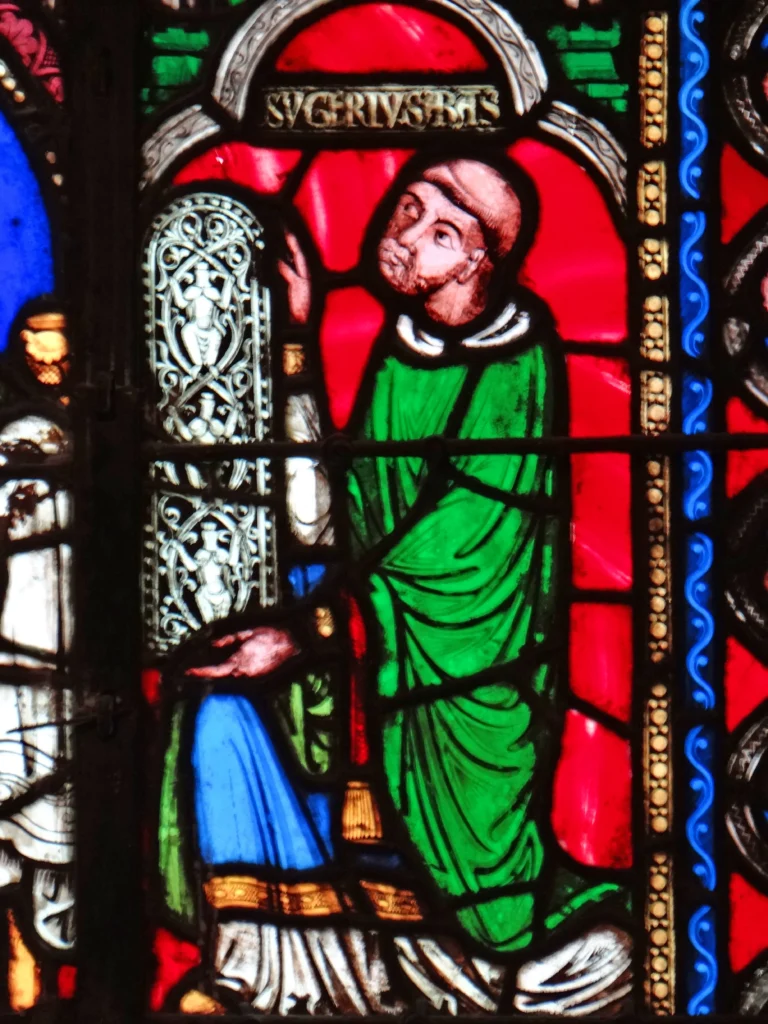
Abbot Suger (c. 1081 – 1151), the patron of the rebuilding of the Abbey church, had begun his career in the church at the age of ten, and rose to become the Abbot in 1122. He was a school companion and then confidant and minister of Louis VI and then of his son Louis VII, and was a regent of Louis VII when the King was absent on the Crusades. He was an accomplished fund-raiser, acquiring treasures for the cathedral and collecting an enormous sum for its rebuilding. In about 1135 he began reconstructing and enlarging the abbey. In his famous account of the work undertaken during his administration, Suger explained his decision to rebuild the church, due to the decrepit state of the old structure and its inability to cope with the crowds of pilgrims visiting the shrine of St Denis.
In the 12th century, thanks largely to Suger, the Basilica became a principal sanctuary of French Royalty, rivalling Reims Cathedral, where the kings were crowned. The Abbey also kept the regalia of the coronation, including the robes, crowns and sceptre.[19] Beginning in 1124, and until the mid-15th century, the kings departed for war carrying the oriflamme, or battle flag, of St. Denis, to give the King the protection of the Saint. It was taken to the Abbey only when France was in danger. The flag was retired in 1488, when the Parisians opened the gates of Paris to invading English and Burgundian armies.
First Phase: The West Front (1135–1140)
Suger began his rebuilding project at the western end of St Denis, demolishing the old Carolingian facade with its single, centrally located door. He extended the old nave westwards by an additional four bays and added a massive western narthex, incorporating a new façade and three chapels on the first floor level.
In the new design, massive vertical buttresses separated the three doorways and horizontal string-courses and window arcades clearly marked out the divisions. This clear delineation of parts was to influence subsequent west façade designs as a common theme in the development of Gothic architecture and a marked departure from the Romanesque. The portals themselves were sealed by gilded bronze doors, ornamented with scenes from Christ’s Passion. They clearly recorded Suger’s patronage with the following inscription:
On the lintel below the great tympanum showing the Last Judgement, beneath a carved figure of the kneeling Abbot, was inscribed the more modest plea;
Receive, stern Judge, the prayers of your Suger, Let me be mercifully numbered among your sheep.
Second Phase: The New Choir, (1140–1144)
Suger’s western extension was completed in 1140 and the three new chapels in the narthex were consecrated on 9 June of that year, but the Romanesque nave between was yet unchanged. He wrote about the new narthex at the west end and proposed chapels at the east: “Once the new rear part is joined to the part in front, the church shines with its middle part brightened. For bright is that which is brightly coupled with the bright, and bright is the noble edifice which is pervaded by the new light.”
Suger’s great innovation in the new choir was the replacement of the heavy dividing walls in the apse and ambulatory with slender columns, so that the interior of that part of the church was filled with light. He described “A circular string of chapels, by virtue of which the whole church would shine with the wonderful and uninterrupted light of most luminous windows, pervading the interior beauty.” One of these chapels was dedicated to Saint Osmanna, and held her relics.
Suger’s masons drew on elements which evolved or had been introduced to Romanesque architecture: the rib vault with pointed arches, and exterior buttresses which made it possible to have larger windows and to eliminate interior walls. It was the first time that these features had all been drawn together; and the new style evolved radically from the previous Romanesque architecture by the lightness of the structure and the unusually large size of the stained glass windows.
The new architecture was full of symbolism. The twelve columns in the choir represented the twelve Apostles, and the light represented the Holy Spirit. Like many French clerics in the 12th century AD, he was a follower of Pseudo-Dionysius the Areopagite, a 6th century mystic who equated the slightest reflection or glint with divine light. Suger’s own words were carved in the nave: “For bright is that which is brightly coupled with the bright/and bright is the noble edifice which is pervaded by the new light.” Following Suger’s example, large stained glass windows filling the interior with mystical light became a prominent feature of Gothic architecture.
Two different architects, or master masons, were involved in the 12th century rebuilding. Both remain anonymous but their work can be distinguished on stylistic grounds. The first, who was responsible for the initial work at the western end, favoured conventional Romanesque capitals and moulding profiles with rich and individualised detailing. His successor, who completed the western facade and upper storeys of the narthex, before going on to build the new choir, displayed a more restrained approach to decorative effects, relying on a simple repertoire of motifs, which may have proved more suitable for the lighter Gothic style that he helped to create.
The Portal of Valois was the last of the Gothic structures planned by Suger. It was designed for the original building, but was not yet begun when Suger died in 1151. In the 13th century it was moved to the end of the new transept on the north side of the church. The sculpture of the portal includes six standing figures in the embracements and thirty figures in the voussures, or arches, over the doorway, which probably represent the Kings of the Old Testament. The scene in the Tympanum over the doorway depicts the martyrdom of Saint Denis. In their realism and finesse, they were a landmark in Gothic sculpture.
The new structure was finished and dedicated on 11 June 1144, in the presence of the King. The Abbey of St Denis thus became the prototype for further building in the royal domain of northern France. Through the rule of the Angevin dynasty, the style was introduced to England and spread throughout France, the Low Countries, Germany, Spain, northern Italy and Sicily.
Reconstruction of the Nave – the Rayonnant Style – Beginning of the Royal Necropolis (13th century)
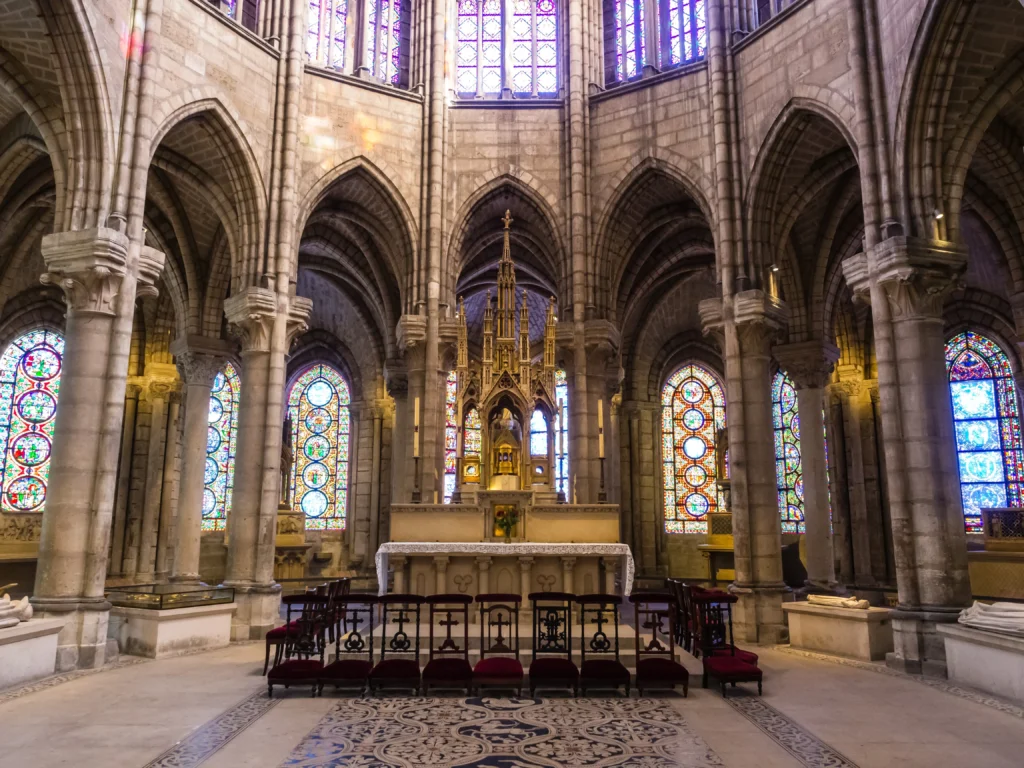
Suger died in 1151 with the Gothic reconstruction incomplete. In 1231, Abbot Odo Clement began work on the rebuilding of the Carolingian nave, which remained sandwiched incongruously between Suger’s Gothic works to the east and west. Both the nave and the upper parts of Suger’s choir were replaced in the Rayonnant Gothic style. From the start it appears that Abbot Odo, with the approval of the Regent Blanche of Castile and her son, the young King Louis IX, planned for the new nave and its large crossing to have a much clearer focus as the French ‘royal necropolis’, or burial place. That plan was fulfilled in 1264 under Abbot Matthew of Vendôme when the bones of 16 former kings and queens were relocated to new tombs arranged around the crossing, eight Carolingian monarchs to the south and eight Capetians to the north. These tombs, featuring lifelike carved recumbent effigies or gisants lying on raised bases, were badly damaged during the French revolution though all but two were subsequently restored by Viollet le Duc in 1860.
The dark Romanesque nave, with its thick walls and small window-openings, was rebuilt using the very latest techniques, in what is now known as Rayonnant Gothic. This new style, which differed from Suger’s earlier works as much as they had differed from their Romanesque precursors, reduced the wall area to an absolute minimum. Solid masonry was replaced with vast window openings filled with brilliant stained glass (all destroyed in the Revolution) and interrupted only by the most slender of bar tracery—not only in the clerestory but also, perhaps for the first time, in the normally dark triforium level. The upper facades of the two much-enlarged transepts were filled with two spectacular 12m-wide rose windows. As with Suger’s earlier rebuilding work, the identity of the architect or master mason remains unknown. Although often attributed to Pierre de Montreuil, the only evidence for his involvement is an unrelated document of 1247 which refers to him as ‘a mason from Saint-Denis’.
15th–17th Century
During the following centuries, the cathedral was pillaged twice; once during the Hundred Years War (1337–1453) and again during the Wars of Religion (1562–1598). Damage was largely limited to broken tombs and precious objects stolen from the altars and treasury. Many modifications were made under Marie de’ Medici and later royal families. These included the construction of chapel adjoining the north transept to serve as a tomb for the monarchs of the Valois Dynasty (later demolished). A plan of c. 1700 by Félibien shows the Valois Chapel, a large mortuary chapel in the form of a domed colonnaded “rotunda”, adjoining the north transept of the basilica and containing the tomb of the Valois. and the display of the skeleton of a baleine whale in the nave in 1771. Greater harm was done with the removal of the early Gothic column-statues which Suger had used to decorate the west front. (They were replaced with replicas in the 19th century). In 1700, reconstruction began of the monastic buildings adjacent to the church. This was not completed until the mid-18th century. Into these buildings Napoleon installed a school for the daughters of members of the French Legion of Honour, which still is in operation.
The French Revolution and Napoleon
Due to its connections to the French monarchy and proximity to Paris, the abbey of Saint-Denis was a prime target of revolutionary vandalism. On Friday, 14 September 1792, the monks celebrated their last services in the abbey church; the monastery was dissolved the next day. The church was used to store grain and flour. In 1793, the National Convention, the revolutionary government, ordered the violation of the sepulchres and the destruction of the royal tombs, but agreed to create a commission to select those monuments which were of historical interest for preservation. In 1798, these were transferred to the chapel of the Petit-Augustins, which later became the Museum of French Monuments.
Most of the medieval monastic buildings were demolished in 1792. Although the church itself was left standing, it was profaned, its treasury confiscated and its reliquaries and liturgical furniture melted down for their metallic value. Some objects, including a chalice and aquamanile donated to the abbey in Suger’s time, were successfully hidden and survive to this day. The jamb figures of the façade representing Old Testament royalty, mistakenly identified as images of royal French kings and queens, were removed from the portals and the tympana sculpture defaced.
In 1794, the government decided to remove the lead tiles from the roof, to melt them down to make bullets. This left the interior of the church badly exposed to the weather.
19th century – Reconstruction and Renovation
The Church was reconsecrated by Napoléon in 1806, and he designated it as the future site for his own tomb and those of his intended dynasty. He also ordered the construction of three chapels to honour the last French kings, created a chapel under the authority of his uncle, Cardinal Fesch, which was decorated with richly-carved choir stalls and marquetry from the Château de Gaillon. (See “Choir Stalls” section below).
After Napoleon’s downfall, the ashes of the previous king, Louis XVI, were ceremoniously moved from the cemetery of the Madeleine to Saint-Denis. The last king to be entombed in Saint-Denis was Louis XVIII in 1824.
In 1813 François Debret was named the chief architect of the cathedral; he proceeded, over thirty years, to repair the Revolutionary damage. He was later best known for his design of the Salle Le Peletier, the primary opera house of Paris before the Opéra Garnier in 1873. He replaced the upper stained glass windows in the nave with depictions of the historic kings of France, and added new windows to the transept depicting the renovation, and the July 1837 visit to the Cathedral of King Louis Philippe. On 9 June, the spire of the tower was struck by lightning and destroyed. Debret rapidly put into place a new spire, but he did not fully understand the principles of Gothic architecture. He made errors in his plans for the new structure, which resulted in the spire and tower collapsing under their own weight in 1845.
Debret resigned and was replaced by Eugène Viollet-le-Duc, who had the support of Prosper Mérimée, the French author who led campaign for the restoration of ruined Gothic architecture in France. Viollet-le-Duc continued working on the Abbey until his death in 1879, and replaced many of the creations conceived by Debret. Viollet-le-Duc focused on the tombs, rearranging and transforming portions of the interior into a vast museum of French sculpture. In the 1860s Emperor Napoleon III asked Viollet-le-Duc to construct an imperial section in the crypt for him and his dynasty, but he was deposed and went into exile before it was begun.
20th and 21st Centuries
In 1895, when the chapter created by Napoleon was dissolved, the church lost its cathedral rank and reverted to being a parish church. It did not become a cathedral again until 1966, with the creation of the new diocese of Saint-Denis. The formal title is now the “Baslilique-cathédrale de Saint-Denis”.
In December 2016, 170 years after the north tower’s dismantlement and following several false starts, the Ministry of Culture again proposed its reconstruction after concluding it was technically feasible—albeit without public funding. An association, Suivez la flèche (“Follow the Spire”), chaired by Patrick Braouezec, has since been established to support the reconstruction, with the aim of raising the necessary funds by opening the reconstruction works to the general public, along the model of the Guédelon Castle. In March 2018, the culture ministry signed an accord with the association, officially launching the reconstruction project, with works expected to commence in May 2020. A year later, French scholars were still divided on the €25 million proposal to reconstruct the spire. In 2023, hundreds of anonymous graves dating from the 5th to the 14th century were discovered in the Basilica. In the same year, the Basilica’s stained glass windows which have been the central focus of a project spanning 25 years, entered the final stage of restoration with a total cost exceeding 2 million euros.
Exterior
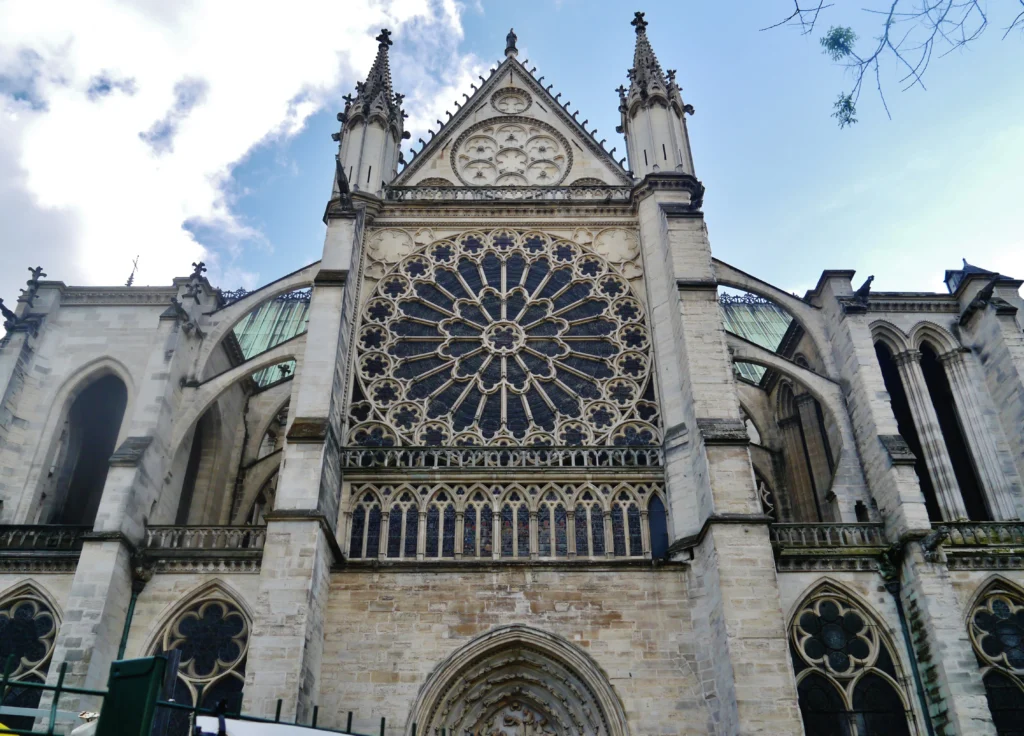
The west front of the church, dedicated on 9 June 1140, is divided into three sections, each with its own entrance, representing the Holy Trinity. A crenellated parapet runs across the west front and connects the towers (still unfinished in 1140), illustrating that the church front was the symbolic entrance to the celestial Jerusalem.
This new façade, 34 metres (112 ft) wide and 20 metres (66 ft) deep, has three portals, the central one larger than those on either side, reflecting the relative width of the central nave and lateral aisles. This tripartite arrangement was clearly influenced by the late 11th century Norman-Romanesque façades of the abbey churches of St Etienne. It also shared with them a three-storey elevation and flanking towers. Only the south tower survives; the north tower was dismantled following a tornado which struck in 1846.
The west front was originally decorated with a series of column statues, representing the kings and queens of the Old Testament. These were removed in 1771 and were mostly destroyed during the French Revolution, though a number of the heads can be seen in the Musée de Cluny in Paris.
The bronze doors of the central portal are modern, but are a faithful reproduction of the original doors, which depicted the Passion of Christ and the Resurrection. One other original feature was added by Suger’s builders; a rose window over the central portal. Although small circular windows (oculi) within triangular tympana were common on the west facades of Italian Romanesque churches, this was probably the first example of a rose window within a square frame, which was to become a dominant feature of the Gothic facades of northern France (soon to be imitated at Chartres Cathedral and many others).
Chevet and Transepts
The chevet, at the east end of the cathedral, was one of the first parts of the structure rebuilt into the Gothic style. The work was commissioned by Abbot Suger in 1140 and completed in 1144. It was considerably modified under the young King Louis IX and his mother, Blanche of Castille, the Regent of the Kingdom, beginning in 1231. The apse was built much higher, along with the nave. Large flying buttresses were added to the chevet, to support the upper walls, and to make possible the enormous windows installed there. The masons used the same engineering concept that was used at the Abbey of Saint-Martin-des-Champs to support the large chapel windows. At the same time, the transept was enlarged and given large rose windows in the new rayonnant style, divided into multiple lancet windows topped by trilobe windows and other geometric forms inscribed in circles. The walls of the nave on both sides were entirely filled with windows, each composed of four lancets topped by a rose, filling the entire space above the triforium. The upper walls, like the chevet, were supported by flying buttresses whose bases were placed between the chapels alongside the nave.
North and South Portals
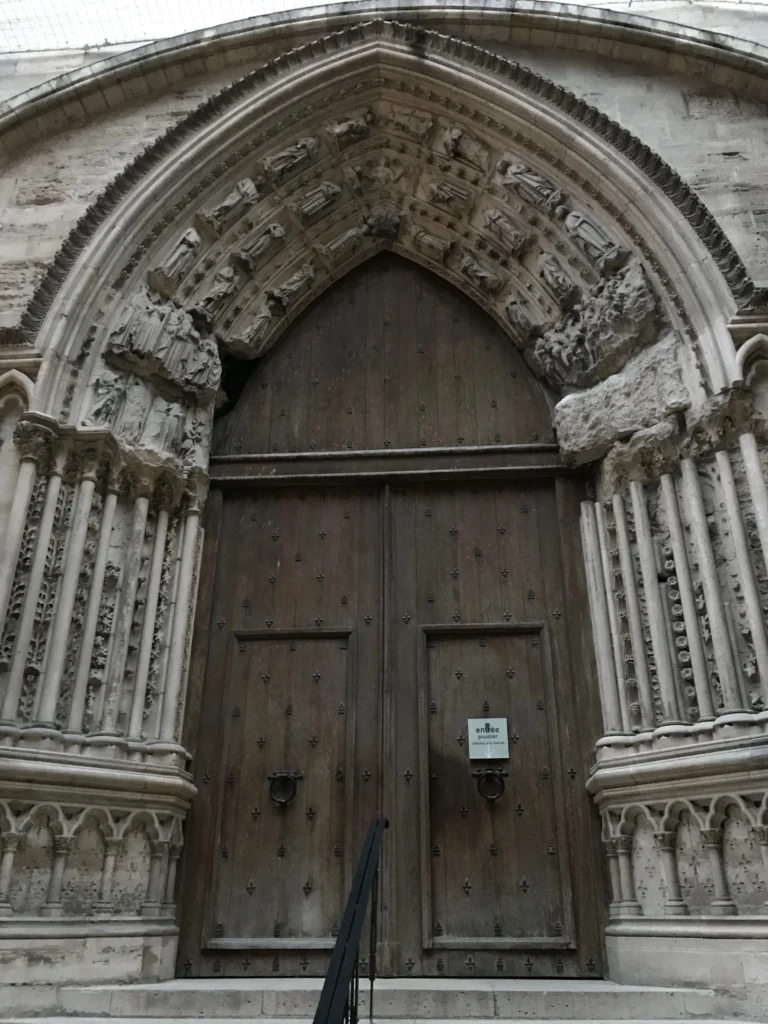
The Porte de Valois, or north portal, was originally built in the 12th century, near the end of Suger’s life, then rebuilt at the end of the north transept in the 13th century. According to Suger, the original entrance on the north did not have sculpture, but mosaic, which Suger replaced by sculpture in 1540. It is considered an important step in the history of Gothic sculpture, because of the skill of the carving, and the lack of rigidity of the figures. There are six figures in the embrasures and thirty figures in the voussures, or arches above the door, which represent kings, probably those of the Old Testament, while the tympanum over the door illustrates the martyrdom of Saint-Denis and his companions Eleuthere and Rusticus. This portal was among the last works commissioned by Suger; he died in 1151, before it was completed. The original sculpture that was destroyed in the Revolution was replaced with sculpture from the early 19th century, made by Felix Brun.
The Tympanum of the south portal illustrates the last days of the Denis and his companions before their martyrdom. The piedroits are filled with medallions representing the labours of the days of month.
Interior
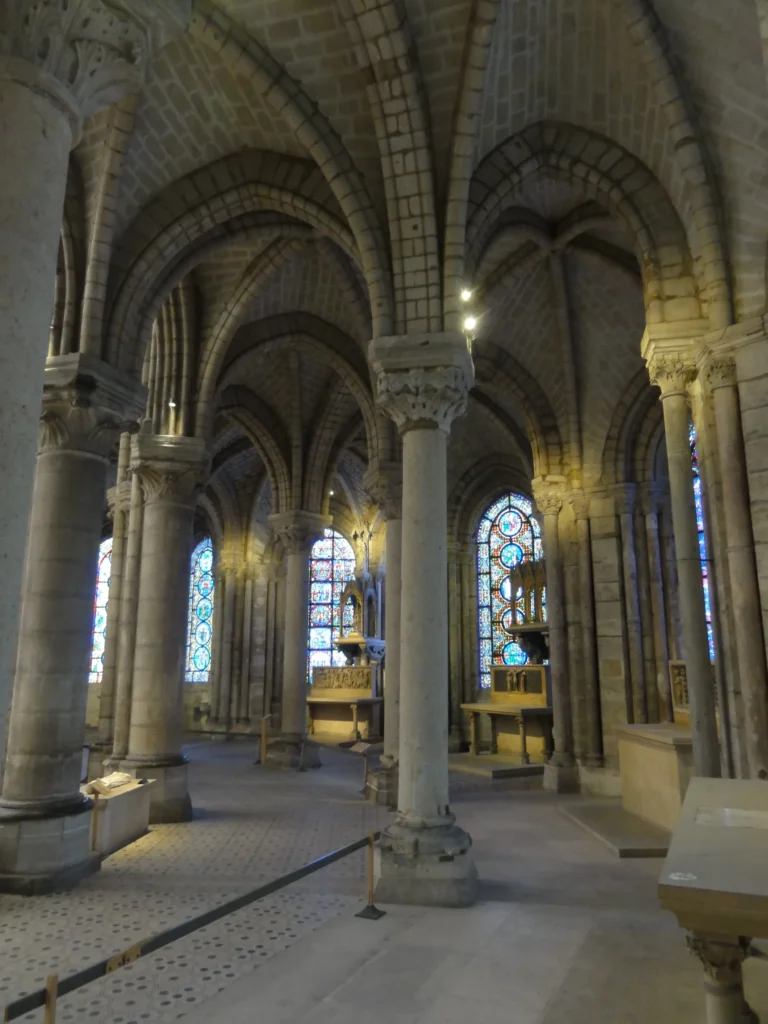
The Nave, the portion to the west of the church reserved for ordinary worshippers, and the choir, the portion to the east reserved for the clergy, were rebuilt into the Gothic style in the 13th century, after the apse at the east and the west front. Like the other Gothic churches in the Ile-de-France, its walls had three levels; large arcades of massive pillars on the ground floor; a narrow triforium or passageway midway up the wall; originally windowless; and a row of high windows the clerestory, above. Slender columns rose from the pillars up the walls to support the four-part rib vaults. As a result of the Rayonnant reconstruction in the triforium was given windows, and the upper walls were entirely filled with glass, which reached upward into the arches of the vaults, flooding the church with light.
The Disambulatory and Chapels
The chevet had been constructed by Suger in record time, in just four years, between 1140 and 1144, and was one of the first great realisations of Gothic architecture. The double disambulatory is divided not by walls but by two rows of columns, while the outside walls, thanks to buttresses on the exterior, are filled with windows. The new system allowed light to pass into the interior of the choir. The disambulatory connects with the five radiating chapels at the east end of the cathedral, which have their own large windows. To give them greater unity, the five chapels share the same system of vaulted roofs. To make the walls between the chapels even less visible, they are masked with networks of slender columns and tracery.
The apse with its two ambulatories and axial chapels was extensively rebuilt in the 12th century, to connect harmoniously with the new and larger nave, but a major effort was made to save the early Gothic features created by Suger, including the double disambulatory with its large windows. To accomplish this, four large pillars were installed in the crypt to support the upper level, and the walls of the first traverse of the sanctuary were placed at an angle to connect with the wider transept.
The basilica retains stained glass of many periods (although most of the panels from Suger’s time have been removed for long-term conservation and replaced with photographic transparencies), including exceptional modern glass, and a set of 12 misericords.
Crypt and Royal Tombs
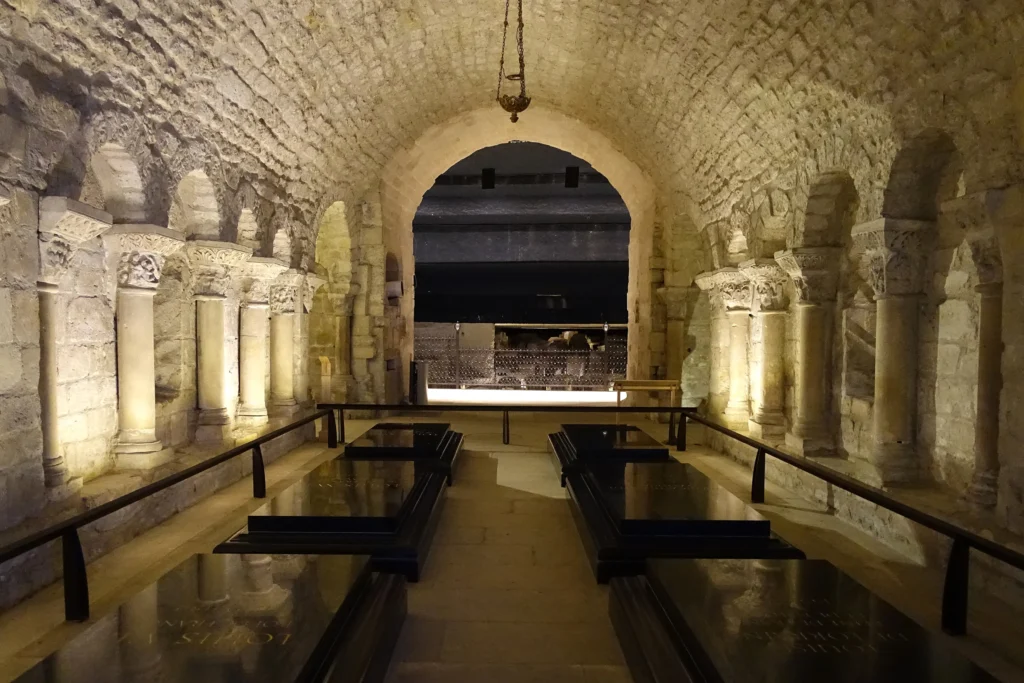
The Basilica of Saint-Denis, located just north of Paris, became the official burial site for French kings starting with Hugh Capet in the 10th century, though earlier monarchs were already interred there. Initially associated with Saint Denis, the first Bishop of Paris, the basilica’s crypt was expanded in the 12th century by Abbot Suger, who introduced Gothic architecture. Over the centuries, the tombs of French monarchs, including Clovis I, Charles Martel, and later, Louis XII and Henri II, adorned the basilica. However, during the French Revolution, many of these royal tombs were desecrated, with remains thrown into mass graves. The Bourbon Restoration in the early 19th century saw the reburial of several royal remains, including those of Louis XVI and Marie Antoinette, while later restoration efforts, led by architect Viollet-le-Duc, returned many monuments to the church. Today, Saint-Denis remains a poignant symbol of France’s monarchy, its cultural legacy, and the dramatic shifts in its political history.
Sacristy
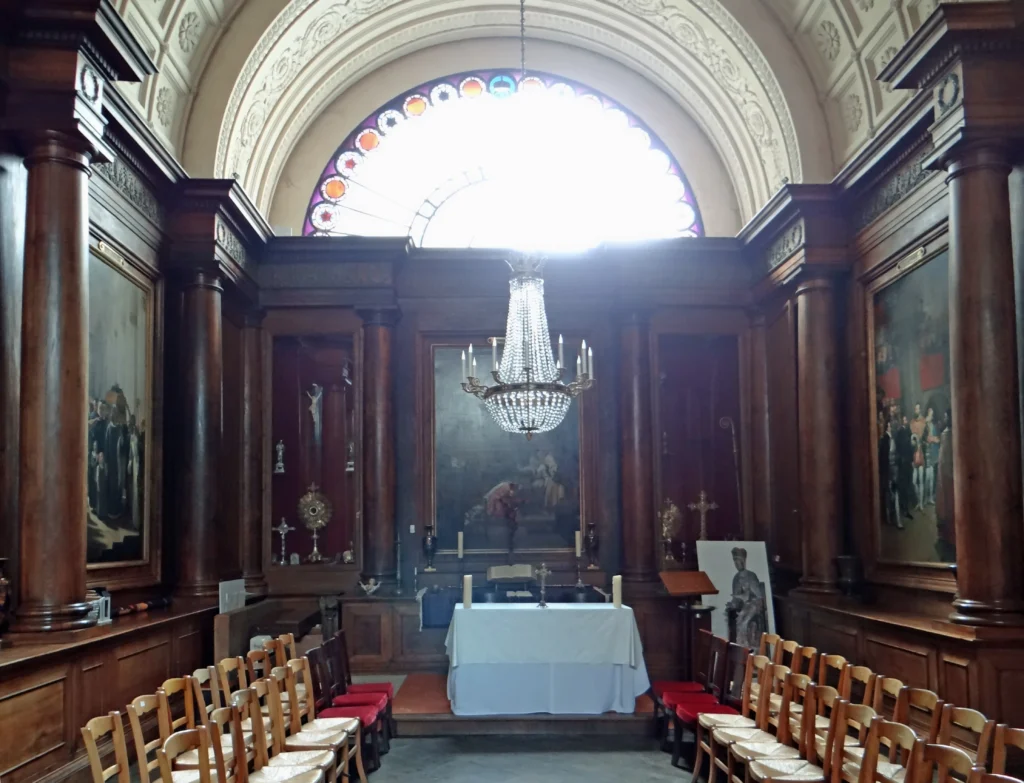
The Sacristy, the room where the clergy traditionally donned their vestments, was transformed by the architect Jacques Cellerier in 1812 into a Neo-classical gallery of murals which depict scenes from the history of the cathedral. A work added to the Sacristy is “Allegory of the Divine Word”, a painting by Simon Vouet, which originally had been commissioned by Louis XIII for the retable of the Chateau of Saint-Germain-en-Laye. It was acquired for the cathedral by the administration of national monuments in 1993. The wall cases also display a selection of precious objects from the cathedral’s collection.
Stained Glass
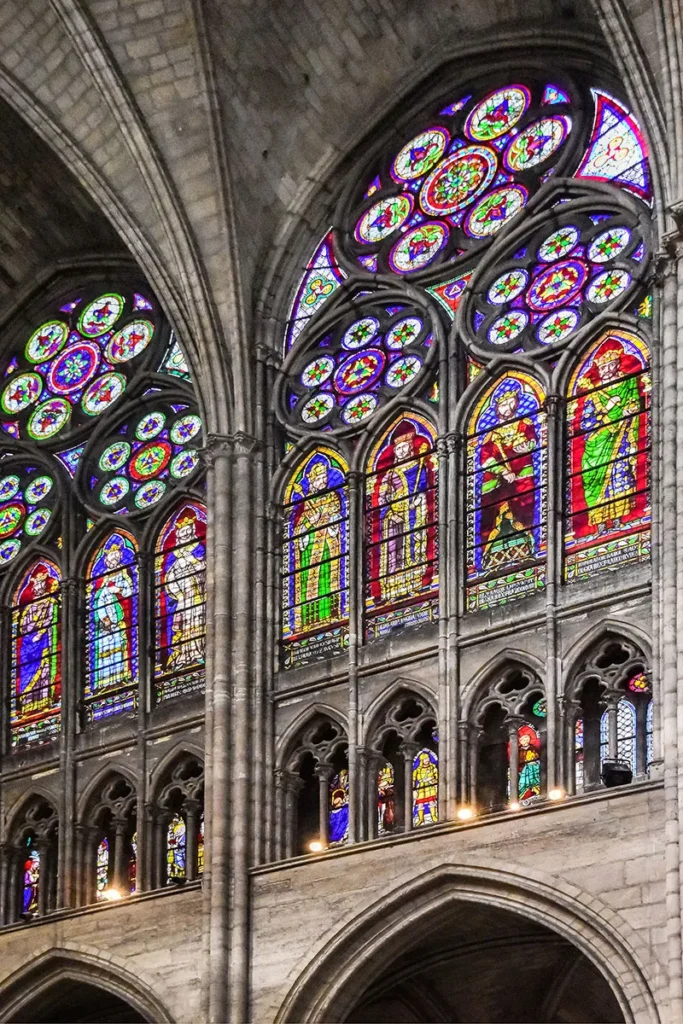
Abbot Suger commissioned a significant amount of stained glass for the basilica’s new chevet, though only a small portion of the original glass from his time remains intact. Some of these surviving pieces were collected by Eugène Viollet-le-Duc in the 19th century and integrated into the church’s windows. Notable examples include a depiction of Suger prostrating himself before Christ in “The Childhood of Christ” window, the Tree of Jesse illustrating Christ’s genealogy in the Axis chapel, and scenes from “The Life of Moses” and “The Allegories of Saint Paul” in the north radiating chapel. Additionally, a window featuring a mythical griffon, symbolizing Paradise, survives in the second north radiating chapel. Many of the original windows Suger described, including scenes of Charlemagne’s pilgrimage and the Crusades, have disappeared. Much of the stained glass seen today dates from the 19th century, when the church was restored after Revolutionary damage. In 1813, architect François Debret designed the first Neo-Gothic windows for the nave, which include representations of French kings and queens. Later windows in the south transept, depicting the restoration of the church and the 1837 visit of Louis Philippe I, were created by painter Jean-Baptiste Debret, the brother of the architect.
Sculpture
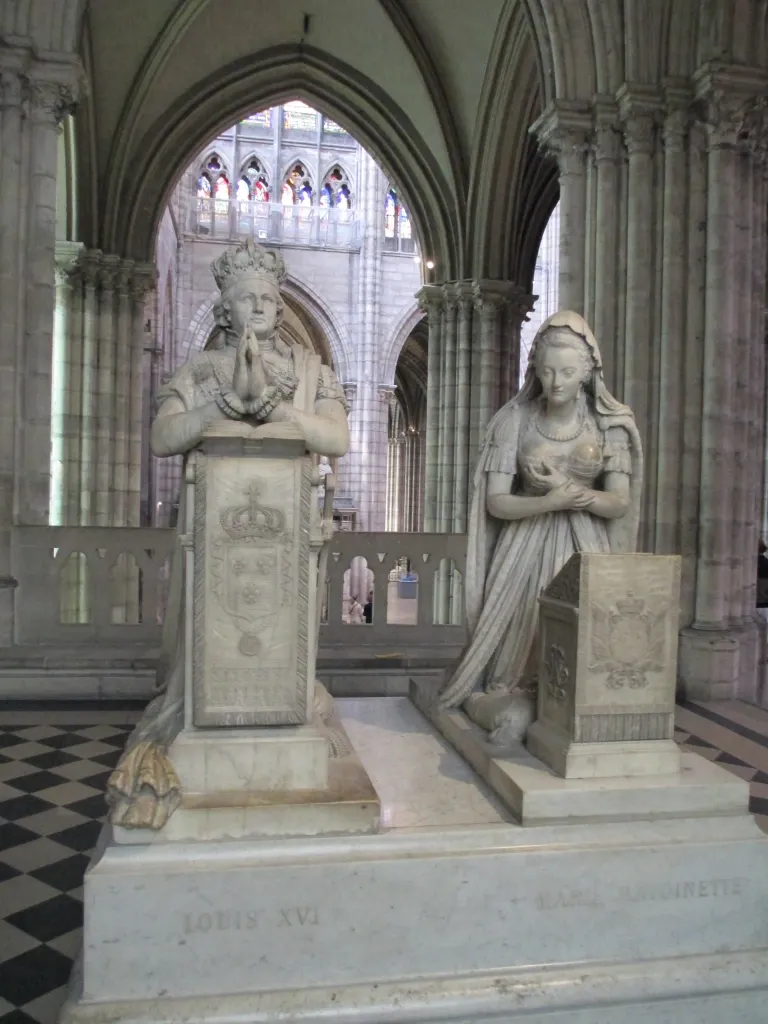
The New West Front Sculpture of Saint-Denis, commissioned by Abbot Suger, played a pivotal role in the development of Gothic style. The façade featured tall, slender statues of Old Testament prophets and kings, known as jamb figures, which flanked the portals. These figures, though destroyed in 1771, were recorded in detailed drawings by Montfaucon and had a profound influence on the design of subsequent Gothic cathedrals, notably those of Paris and Chartres, and became a defining feature of Gothic portals thereafter. The statues on the Valois portal, created in 1175, were particularly significant for their elongated and expressive forms, which contrasted with the more restrained figures seen at Chartres, also from the same period, and helped shape the emotional expressiveness of Gothic sculpture. Above the portals, the central tympanum depicted Christ in Majesty, showing his wounds with the dead rising from their tombs beneath him. The south portal featured scenes from the martyrdom of Saint Denis, while a mosaic (now lost) adorned the north portal, a design choice Suger noted as unconventional for the time. Sadly, much of the original sculpture has been lost or damaged, with what remains largely the result of a clumsy restoration in 1839. Some fragments of the original works are preserved in the Musée de Cluny.
Choirs and Organ
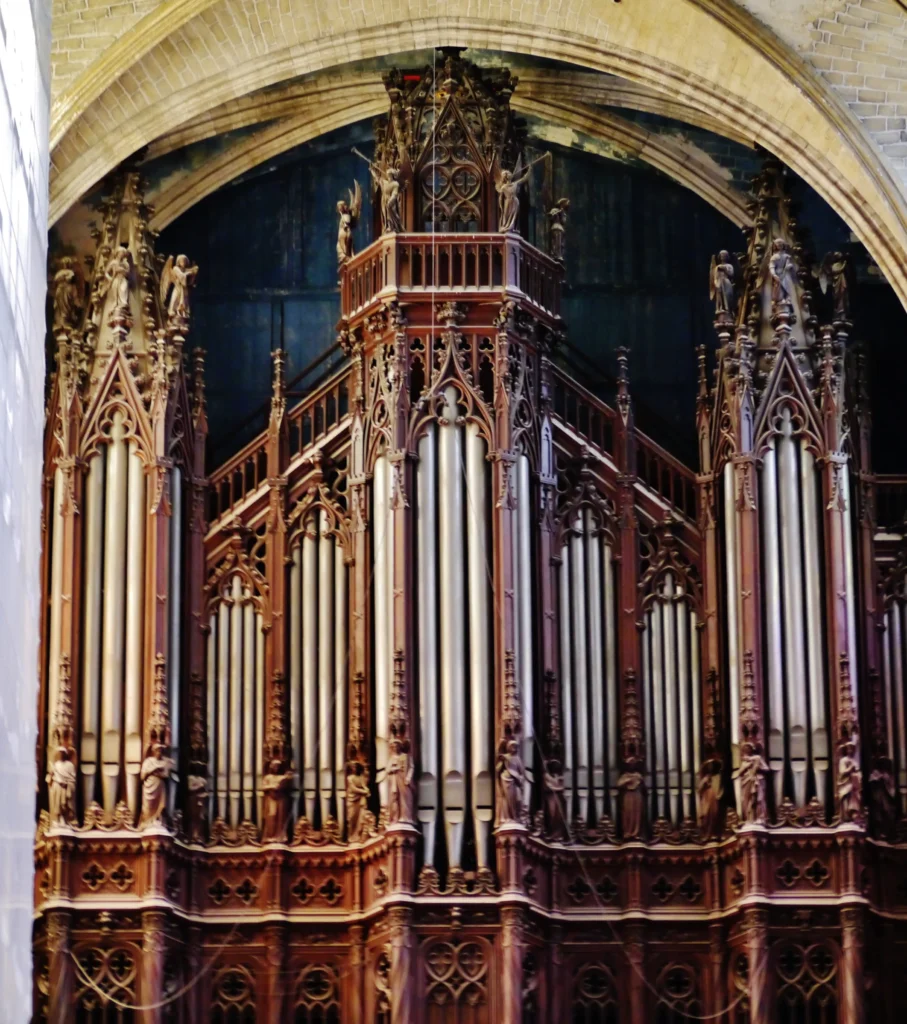
The Choir stalls, the seats reserved for the clergy, have particularly fine carvings, particularly on the misericord, the small seat on each stall on which the clergy could rest when standing for long periods of time. The stalls were made in the 16th century, and were originally located in the high chapel of the Chateau de Gaillon in the Eure Department. In 1805 Napoleon Bonaparte decided to create three new chapels at Saint-Denis, as well as a chapter of bishops under the authority of his uncle, Cardinal Fesch. The stalls were moved to Saint-Denis and installed for their use. Besides the carved wood, the stalls are decorated with elaborate multi-coloured religious scenes in marquetry.
The Organ at the Basilica of Saint-Denis is located on the tribune, at the west end of the nave. An organ was first recorded at the basilica in 1520, and a later instrument by Crespin Carlier was noted in the same year, though this was destroyed during the French Revolution. When the church reopened in 1806, it was without an organ, and a competition was held in 1833 to select a builder for a new one. The competition was won by the 23-year-old Aristide Cavaillé-Coll, marking his first major commission and the beginning of his illustrious career as an organ builder. The organ was completed in 1843 and featured several innovations of the Romantic era, notably the first-ever Barker lever. With three manuals, pedals, and a significant historical legacy, the instrument is now protected as a Monument historique. It was restored in 1901 by Charles Mutin and again between 1983 and 1987 by Jean-Loup Boisseau and Bertrand Cattiaux. Pierre Pincemaille, the basilica’s sole titular organist from 1987 to 2018, performed numerous recitals and recorded eight CDs on the instrument, further cementing its place in the organ music world.
Treasury
The cathedral contained an extensive treasury, mainly constituted by the Abbot Suger. It contained crowns (those of Charlemagne, Saint Louis, and Henry IV of France), a cross, and liturgical objects.
Feast Day
Feast Day : 9th October
Saint Denis was a missionary and the first bishop of Paris. He was killed for his Christian faith by pagans on what is known as the “Montmartre” – the mount of martyrs – in 258, along with Eleutherius and Rusticus, a priest and a deacon. He is the patron saint of France. His Feast Day October 09.
Church Mass Timing
Mass times at the Cathedral
Tuesday : 9:00 AM
Wednesday : 9:00 AM
Thursday : 9:00 AM
Friday : 9:00 AM
Sunday : 8:30 AM , 10:00 AM and 6:00 PM
Church Opening Time:
Monday : 10.00 AM – 05:15 PM
Tuesday : 10.00 AM – 05:15 PM
Wednesday : 110.00 AM – 05:15 PM
Thursday : 10.00 AM – 05:15 PM
Friday : 10.00 AM – 05:15 PM
Saturday : 10.00 AM – 05:15 PM
Sunday : 12.00 PM –5:15 PM
Contact Info
Address :
1 Rue de la Légion d’Honneur,
93200 Saint-Denis, France
Phone : +33 1 48 09 83 54
Accommodations
Connectivities
Airway
Paris Charles de Gaulle Airport (CDG) to Basilica of Saint-Denis France Distance 35 min (22.3 km) via D170
Railway
Cimetière de Saint-Denis Station to Basilica of Saint-Denis France Distance 2 min (300.0 m) via Bd de la Commune de Paris and Rue du Pont Godet

